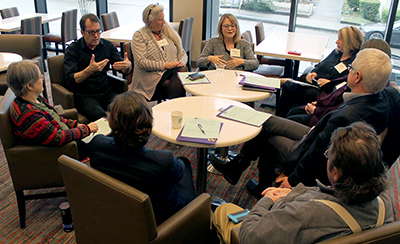Discussion Summaries

Participants were asked to form small groups to discuss the following questions. Examples of participant responses are listed below the questions.
What Models, Frameworks or Approaches They Use in Their Own Practice, How They Use Them, and the Factors That Influence the Value and Utility of the Models, Frameworks or Approaches
- There is not any one model that any university is using. Using the micro, miso, and macro level allows us to think about our models differently.
- There is a vast difference between having a law where an institution can get sued, verse an institution doing something out of the goodness of its own heart. What can we use to motivate institutions, companies, and people?
- As technology moves forward, things can be made more accessible easier, but there will also be more to be made accessible.
- Litigation and other big events can cause a culture shift to move towards accessibility. Faculty won’t prioritize accessibility without a reason or reward.
- Standardization is easier within K-12 due to state and federal standards and expected student completion. Each post-secondary institution can often run things differently.
- Academic freedom should be overridden by the need for access to content.
- There can be an absence of tools that can be used to make products accessible by default. All the software that comes on computers today does not have good accessibility built-in, and software needs user training to make documents accessible.
- I usually don’t have time to think about the reasons behind what I do. We kept coming back to the idea of universal design and how WCAG 2.0 can be made relevant to making all web content accessible.
- “Everyday accessibility” as an idea for the work we are doing every day and how we are specifically getting the work done.
- What is the function or purpose of a model? To explain functionality of practice or is it to create better practice? If a model is to explain practice, it needs to observe actual practice instead of just create the idea of a practice.
- Standards can sometimes be created without meeting the audience the message or model is for. Standards need to be pragmatic and palatable.
- Optimal accessibility—we can have a goal for ideal practice, but also understand what is realistic for practice. We don’t want to set something as unachievable, because then no one will even try.
- There is a lot of tensions between the two extremes—from the medical model to the social model, or academic freedom and standards.
- Students can be a great help in moving the grassroots movement further. Often, accessibility issues are left on the shoulders of individual students. Instead, we want to help students and move forward as a group, creating a coalition to advocate for accessibility.
Should we be using models and frameworks, or should we ditch this conversation entirely?
- I’m not sure if the models or frameworks help, but without them, we would have no way to share ideals and methods of practice.
- If a model is too prescriptive, it takes away the need of freedom within a culture. Not every part of a model is going to be worked out in the same way. Models need to be adaptable for a variety of cultures and environments. There will probably never be one model for all.
- Eventually you can put a hypothesis into a model and look at the efficacy of a model. You can never test a method if you don’t have a model for it. Models can be used to train and build around. Teachability and Testability.
- Accessibility is, at heart, a compliance issue. Security also is, at its heart, a compliance issue. By making a more generalized compliance roadshow, by partnering with general council and risk management, we can broaden our team to move accessibility further.
- We now have a compliance verse social justice, or moral issue verse economic issue. There are a variety of “hammers” to use to promote accessibility, and we don’t know which method is the right way to go.
- Models can grow and change—they are not stagnant disciplines to be used or not used.
- Faculty often want to see examples. If a model is just a theory, it’s harder to get people to sign on board with trying it.
- If we were bringing an idea to a fully new country with no background, how would we start it or bring it to them? What burdens do we carry with us that are avoided elsewhere?
- Maybe instead of one model, we need many micromodels. Inaccessibility is like a cancer—and there isn’t one way to treat or prevent cancer. Maybe we need many ways to treat and prevent inaccessibility.
- Low-hanging fruit can be hit easier. My unit offered to open the door to fix easy issues (creating templates, cleaning code, creating accessible PDFs, etc.), and that really invited people to come in and try to fix these problems.